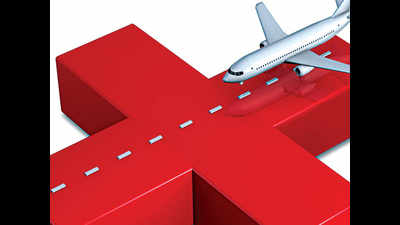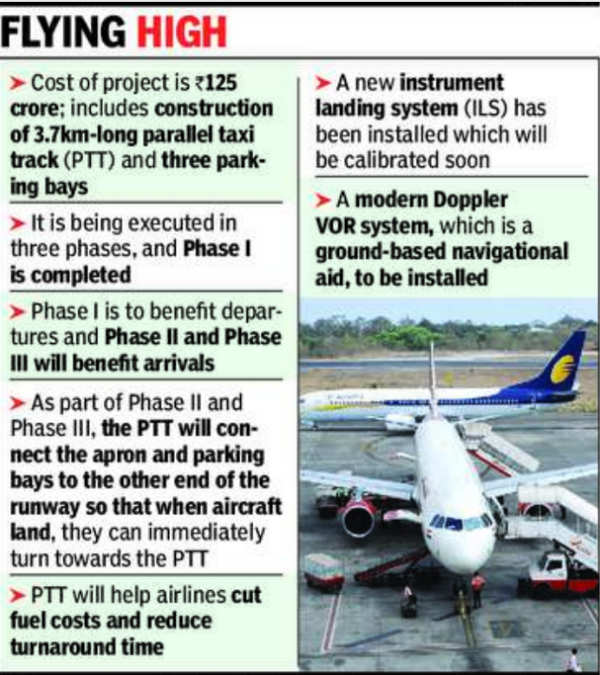Trending
This story is from October 14, 2019
AAI, Navy explore feasibility of more flights from Goa airport
With plans to operationalise the parallel taxi track (PTT) at Goa International Airport by November 15, the Airports Authority of India has simultaneously begun discussions with the Indian Navy to see if additional slots for flight operations are possible at the state’s lone airport.

Representative image
PANAJI: With plans to operationalise the parallel taxi track (PTT) at Goa International Airport by November 15, the Airports Authority of India has simultaneously begun discussions with the Indian Navy to see if additional slots for flight operations are possible at the state’s lone airport.

Speaking to TOI, Goa airport director Gagan Malik said that with phase I of the parallel taxi track already being used for departures, authorities have seen a five-minute reduction in departure timings.
“Once we commission the entire PTT there will definitely be more time saved and airlines will save on fuel too,” Malik said. “We have started serious deliberations with the Navy and air traffic controllers to see if the number of arrivals and departures can be increased,” he added.
The airport director also said that AAI has thrown open three remote parking bays, which now allows Goa Airport to handle eleven flights simultaneously instead of the earlier eight.
Dilip Buildcon Ltd (DBL) is executing the Rs 125-crore project, which includes construction of a 3.7km-long parallel taxi track and three parking bays for aircraft. AAI took up the work to build the parallel taxiway in order to be able to operate more flights from the airport, which is part of the Indian Navy air base, INS Hansa.
AAI received the environmental clearance for the project from the Union ministry of environment and forests, in January 2018.
“The taxi track lighting has already been installed. We have also installed a new instrument landing system (ILS), which is category II and category III compatible,” the director said.
As part of Phase II and Phase III, the PTT will connect the apron and parking bays to the other end of the runway so that when aircraft land, then can immediately turn towards onto the PTT. Currently, after landing, aircraft have to use the Indian Navy’s PTT and then cross the runway to arrive at the terminal.
“Runway occupancy time is reduced this way and aircraft need not hold before take-off or circle till the runway is clear. This means that the availability of the runway will increase. In departures we are going to have savings of four to five minutes,” Malik said.
The additional parking bays and the taxi track will come in handy. This is because the number of aircraft movements hover around 180 per day.
The number of arrivals and departures increases to 190 per day between the months of October to February when there are charter flights.

Speaking to TOI, Goa airport director Gagan Malik said that with phase I of the parallel taxi track already being used for departures, authorities have seen a five-minute reduction in departure timings.
“Once we commission the entire PTT there will definitely be more time saved and airlines will save on fuel too,” Malik said. “We have started serious deliberations with the Navy and air traffic controllers to see if the number of arrivals and departures can be increased,” he added.
On October 10, AAI initiated ‘trial commissioning’ of the first phase of the PTT, which connects the terminal apron and parking bays to one end of the runway, from where aircraft begin take-off from runway 26.
The airport director also said that AAI has thrown open three remote parking bays, which now allows Goa Airport to handle eleven flights simultaneously instead of the earlier eight.
Dilip Buildcon Ltd (DBL) is executing the Rs 125-crore project, which includes construction of a 3.7km-long parallel taxi track and three parking bays for aircraft. AAI took up the work to build the parallel taxiway in order to be able to operate more flights from the airport, which is part of the Indian Navy air base, INS Hansa.
AAI received the environmental clearance for the project from the Union ministry of environment and forests, in January 2018.
“The taxi track lighting has already been installed. We have also installed a new instrument landing system (ILS), which is category II and category III compatible,” the director said.
As part of Phase II and Phase III, the PTT will connect the apron and parking bays to the other end of the runway so that when aircraft land, then can immediately turn towards onto the PTT. Currently, after landing, aircraft have to use the Indian Navy’s PTT and then cross the runway to arrive at the terminal.
“Runway occupancy time is reduced this way and aircraft need not hold before take-off or circle till the runway is clear. This means that the availability of the runway will increase. In departures we are going to have savings of four to five minutes,” Malik said.
The additional parking bays and the taxi track will come in handy. This is because the number of aircraft movements hover around 180 per day.
The number of arrivals and departures increases to 190 per day between the months of October to February when there are charter flights.
End of Article
FOLLOW US ON SOCIAL MEDIA










